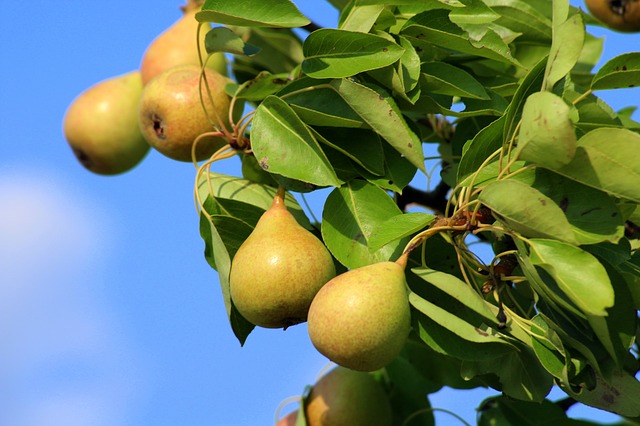
The pear is a 5-15m tall tree. It is characterized by a strong root system and a dense crown. Branches with thorns. The new shoots tend to be of two types: elongated-vegetative and shortened-generative, on which flowers and later fruits are formed. Leaves simple, arranged alternately, round or oval, entire edge or toothed, with a strong wax coating, leathery, shiny on the surface, on a long stem. Flowers bisexual, white or pink, regular (actinomorphic), arranged in shield-shaped inflorescences.
The fruit is a pear. Blooms in April-May. The fruits ripen from August to October.
Both fresh and dried fruits are used for medicinal purposes. They are collected when they are ripe, then dried in dryers or ovens at a temperature of 70-85C, it is also allowed to dry in the sun. Store in boxes, in well-ventilated areas. Can be stored for 1 year.
Pear fruits contain a lot of sugar, organic acids (citric, coffee, boron, apple), tannins, starch, fiber, enzymes, pectins, essential oils, vitamins: B1, C, A, PP, rutin, as well as minerals (potassium, sodium, calcium, phosphorus, magnesium, iron, copper, iodine) and quinine. Pear leaves contain phenolic acids, flavonoids, alkaloids and nitrogenous compounds.
Medicinal significance
Pear fruit has diuretic, antipyretic, anti-inflammatory, antibacterial, antipyretic and astringent properties. Jellys and compotes, in which dried pear fruits are added, strengthen blood vessel walls, help remove excess salts, water, toxic substances, heavy metals from the body, and they also clean the digestive tract.
Pear fruit is the best prevention of sclerosis. Pear seeds have anti-helminthic activity. It was determined experimentally (Lee H., 2007.) Pear fruits have a tonic effect, having a beneficial effect on the activity of the heart and CNS in stressful situations.
In folk medicine, pear has been used as a remedy since ancient times. It is mainly used as an analgesic, antiseptic, diuretic, tonic. For example, a decoction of dried fruits is used to treat fever, diarrhea, headache (compress on the forehead), digestive tract problems. Boiled and stewed pear fruits help effectively to get rid of a strong and suffocating cough, tuberculosis and pneumonia.
Fresh pear fruits and pomace in sugar are used in folk medicine to treat diseases of the esophagus, used as an astringent. A decoction of dried pears is useful for the treatment of upper respiratory tract and cold diseases. Pear fruit juice is used in case of kidney stones, as a diuretic.
Pears are also recommended to be included in the diet of diabetics. Pear fruits are often used prophylactically and to treat prostatitis, kidneys, to restore the function of the intestinal tract, strengthen blood vessels, stop internal bleeding, as well as to get rid of inflammation in the gallbladder and its ducts, as well as in the urinary system.
In folk medicine, pear fruits are used as a remedy for vitiligo.